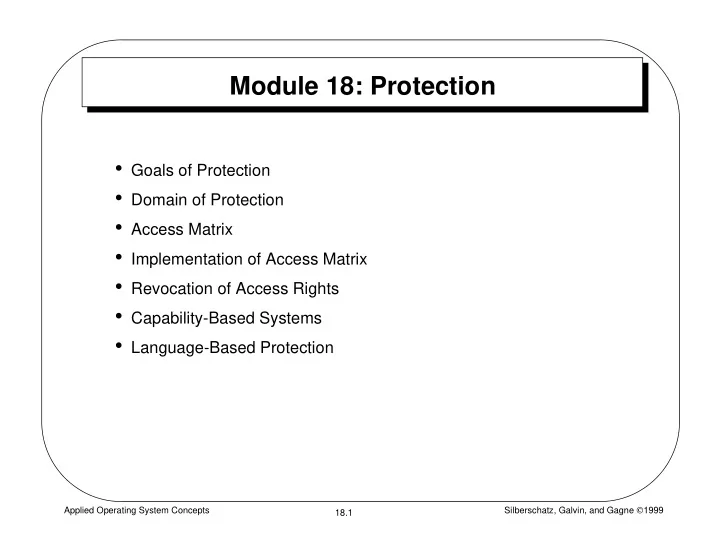

Module 18: Protection • Goals of Protection • Domain of Protection • Access Matrix • Implementation of Access Matrix • Revocation of Access Rights • Capability-Based Systems • Language-Based Protection Silberschatz, Galvin, and Gagne 1999 Applied Operating System Concepts 18.1
Protection • Operating system consists of a collection of object|s, hardware or software • Each object has a unique name and can be accessed through a well-defined set of operations. • Protection problem - ensure that each object is accessed correctly and only by those processes that are allowed to do so. Silberschatz, Galvin, and Gagne 1999 Applied Operating System Concepts 18.2
Domain Structure • Access-right = <object-name, rights-set> Rights-set is a subset of all valid operations that can be performed on the object. • Domain = set of access-rights Silberschatz, Galvin, and Gagne 1999 Applied Operating System Concepts 18.3
Domain Implementation • System consists of 2 domains: – User – Supervisor • UNIX – Domain = user-id – Domain switch accomplished via file system. ✴ Each file has associated with it a domain bit (setuid bit). ✴ When file is executed and setuid = on, then user-id is set to owner of the file being executed. When execution completes user-id is reset. Silberschatz, Galvin, and Gagne 1999 Applied Operating System Concepts 18.4
Multics Rings • Let D i and D j be any two domain rings. • If j < I ⇒ D i ⊆ D j Silberschatz, Galvin, and Gagne 1999 Applied Operating System Concepts 18.5
Access Matrix Figure 1 Silberschatz, Galvin, and Gagne 1999 Applied Operating System Concepts 18.6
Use of Access Matrix • If a process in Domain D i tries to do “op” on object O j , then “op” must be in the access matrix. • Can be expanded to dynamic protection. – Operations to add, delete access rights. – Special access rights: ✴ owner of O i ✴ copy op from O i to O j ✴ control – D i can modify D j s access rights ✴ transfer – switch from domain D i to D j Silberschatz, Galvin, and Gagne 1999 Applied Operating System Concepts 18.7
Use of Access Matrix (Cont.) • Access matrix design separates mechanism from policy. – Mechanism ✴ Operating system provides Access-matrix + rules. ✴ If ensures that the matrix is only manipulated by authorized agents and that rules are strictly enforced. – Policy ✴ User dictates policy. ✴ Who can access what object and in what mode. Silberschatz, Galvin, and Gagne 1999 Applied Operating System Concepts 18.8
Implementation of Access Matrix • Each column = Access-control list for one object Defines who can perform what operation. Domain 1 = Read, Write Domain 2 = Read Domain 3 = Read � • Each Row = Capability List (like a key) Fore each domain, what operations allowed on what objects. Object 1 – Read Object 4 – Read, Write, Execute Object 5 – Read, Write, Delete, Copy Silberschatz, Galvin, and Gagne 1999 Applied Operating System Concepts 18.9
Access Matrix of Figure 1 With Domains as Objects Figure 2 Silberschatz, Galvin, and Gagne 1999 Applied Operating System Concepts 18.10
Access Matrix with Copy Rights Silberschatz, Galvin, and Gagne 1999 Applied Operating System Concepts 18.11
Access Matrix With Owner Rights Silberschatz, Galvin, and Gagne 1999 Applied Operating System Concepts 18.12
Modified Access Matrix of Figure 2
Revocation of Access Rights • Access List – Delete access rights from access list. – Simple – Immediate • Capability List – Scheme required to locate capability in the system before capability can be revoked. – Reacquisition – Back-pointers – Indirection – Keys
Capability-Based Systems • Hydra – Fixed set of access rights known to and interpreted by the system. – Interpretation of user-defined rights performed solely by user's program; system provides access protection for use of these rights. • Cambridge CAP System – Data capability - provides standard read, write, execute of individual storage segments associated with object. – Software capability -interpretation left to the subsystem, through its protected procedures.
Language-Based Protection • Specification of protection in a programming language allows the high-level description of policies for the allocation and use of resources. • Language implementation can provide software for protection enforcement when automatic hardware- supported checking is unavailable. • Interpret protection specifications to generate calls on whatever protection system is provided by the hardware and the operating system.
Recommend
More recommend